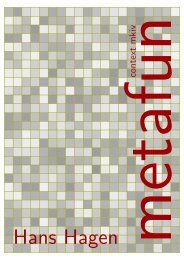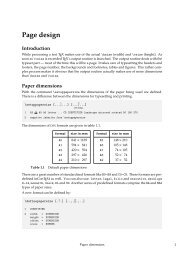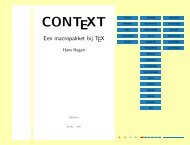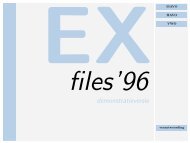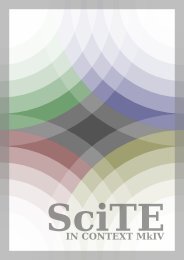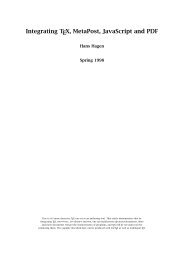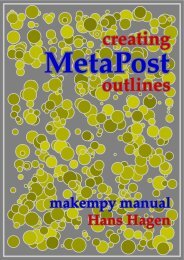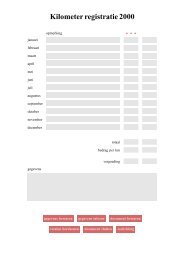Hagen - Pragma ADE
Hagen - Pragma ADE
Hagen - Pragma ADE
Create successful ePaper yourself
Turn your PDF publications into a flip-book with our unique Google optimized e-Paper software.
56<br />
Features<br />
of all, all we get to see is a Lua table, and in ConT E Xt even that one gets sanitized and<br />
optimized into a more useable table. However, as the data that comes with a font is a<br />
good indication of what a font is capable of, we will discuss some of it in an appendix.<br />
In this section we will discuss the basic principles and categories of features.<br />
5.2.2 Feature sets<br />
Because in the next examples we will demonstrate features, we need to know how we<br />
can tell ConT E Xt what features to use. Although you can add explicit feature definitions<br />
to a font specification, I strongly advice you not to do this but use the more abstract<br />
mechanism of feature sets. These are defined as follows:<br />
\definefontfeature<br />
[MyFeatureSet]<br />
[alpha=yes,<br />
beta=no,<br />
gamma=123]<br />
Such a set is bound to a font with the * specifier, as in:<br />
\definefont<br />
[MyFontInstance]<br />
[MyNiceFont*MyFeatureSet at 12pt]<br />
In most cases the already defined default feature set will suffice. It often makes sense<br />
to use that one as base for new definitions:<br />
\definefontfeature<br />
[MyFeatureSet]<br />
[default]<br />
[alpha=yes,<br />
beta=no,<br />
gamma=123]<br />
The second argument can be a list, as in:<br />
\definefontfeature<br />
[MyFeatureSet]<br />
[MyFirstSet,MySecondSet]<br />
[alpha=yes,<br />
beta=no,<br />
gamma=123]<br />
Of course you need to know what features a font support, and one way to find out is:<br />
mtxrun --script font --list --info --pattern=pagella



